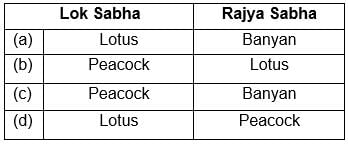General Knowledge Mock Test - 4 - CDS MCQ
30 Questions MCQ Test CDS (Combined Defence Services) Mock Test Series 2024 - General Knowledge Mock Test - 4
Which one among the following correctly represents the theme on which the interiors of the new Parliament Building is based?


| 1 Crore+ students have signed up on EduRev. Have you? Download the App |
Sonic boom is produced when a source of sound travels at a speed:
In the following simplified diagram of at plant cell, five parts / organelles are marked from 1 to 5:

Which one of the following correctly represents the above parts / organelles?
Other things remaining constant, the market supply for a good increases if:
1. its price increases.
2. price of its factors of production decreases.
3. price of other goods decreases.
Select the correct answer using the code given below:
Which one of the following pairs of events and years is not correctly matched?
Which one among the following are the correct symbols for the elements gold, tin and lead, respectively?
Which of the following statements is/are correct?
1. Shivaji sent an ambassador to Bombay to negotiate an agreement with the English.
2. His chief motive was to secure English aid against the Siddis of Danda - Rajpuri.
3. He wanted a supply of grenades, mortars and other ammunition.
Select the correct answer using the code given below:
In which one of the following cities is the Heliopolis Commonwealth War Grave Cemetery located?
Which of the following are included in the definition of Narrow Money?
1. Currency with the public
2. Demand deposits
3. 'Other' deposits with Reserve Bank of India
4. Banker's deposits with Reserve Bank of India
Select the correct answer using the code given below:
Which of the following is / are United Nations Sustainable Development Goal(s)?
1. Decent work and economic growth
2. Peace, justice and strong institutions
3. Responsible consumption and production
Select the correct answer using the code given below:
Which one of the following is not a permanent member of the UN Security Council?
Which one of the following statements about plantation agriculture is not correct?
Which one among the following substances is a compound?
Which country has recently become the world's third-largest economy, following an unexpected recession in Japan in Feb 2024?
Consider the following statements regarding poverty in India:
1. While determining poverty line in India, a minimum level of food requirement, clothing, footwear, fuel and light, educational and medical requirements, etc. are determined for subsistence.
2. The accepted average calorie requirement in India is 2400 calories per person per day in rural areas and 2100 calories per person per day in urban areas.
Which of the statements given above is/are correct?
Which one among the following is the highest mountain in Africa?
Consider the following statements about some planets in the solar system:
1. Mercury has no atmosphere.
2. Venus has two moons.
3. There is no land on Jupiter.
4. Rings of Saturn are composed of lumps of ice and dust.
Which of the statements given above are correct?
Match List I with List II and select the correct answer using the code given below the Lists:

Which of the following pairs of revolution in agriculture sector and its production are correctly matched?
1. Pink revolution : Shrimp production
2. Yellow revolution : Oilseeds production
3. Black revolution : Biodiesel production
4. Golden revolution : Egg production
Select the correct answer using the code given below:
Arrange the following events associated with Shivaji in chronological order:
1. Attack on Afzal Khan
2. Capture of Torna
3. Attack on Shaista Khan
4. Annexation of Javli
Select the correct answer using the code given below:
Which of the following pairs is / are correctly matched?

Select the correct answer using the code given below:
|
23 docs|73 tests
|
|
23 docs|73 tests
|





















